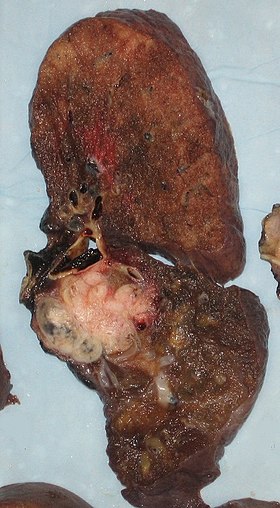| Pneumonectomy | |
|---|---|
 Appearance of the cut surface of a pneumonectomy specimen containing lung cancer, here a squamous cell carcinoma (the whitish tumor near the bronchi). | |
| ICD-9-CM | 32.5 |
| MeSH | D011013 |
A pneumonectomy (or pneumectomy) is a surgical procedure to remove a lung. It was first successfully performed in 1933 by Dr. Evarts Graham. This is not to be confused with a lobectomy or segmentectomy, which only removes one part of the lung.
There are two types of pneumonectomy: simple and extrapleural. A simple pneumonectomy removes just the lung. An extrapleural pneumonectomy also takes away part of the diaphragm, the parietal pleura, and the pericardium on that side.[1]
- ^ Opitz I, Weder W (June 2017). "A nuanced view of extrapleural pneumonectomy for malignant pleural mesothelioma". Annals of Translational Medicine. 5 (11): 237. doi:10.21037/atm.2017.03.88. PMC 5497104. PMID 28706905.